Search results for: 'inst'
- Related search terms
- instr
- instruc
- instruct
- instruction
- instru
-
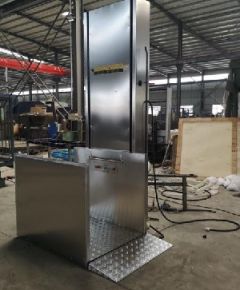 P-8854 WHEELCHAIR HYDRAULIC VERTICAL PLATFORM LIFTP-8854 WHEELCHAIR HYDRAULIC VERTICAL PLATFORM LIFT PLATFORM SIZE: 1200mm(L)X1000mm(W) DIMENSION: 1200mm(L)X1450mm(W)X CUSTOMIZED(H) MAX PLATFORM HEIGHT: 60mm CONFIGURATION: OPEN THROUGH OR FRONT AND SIDE ENTRANCES SPEED: 60mm LOAD CAPACITY: 250KG CONTROL VOLTAGE: 24V/DC QUANTITY: 1 Learn More
P-8854 WHEELCHAIR HYDRAULIC VERTICAL PLATFORM LIFTP-8854 WHEELCHAIR HYDRAULIC VERTICAL PLATFORM LIFT PLATFORM SIZE: 1200mm(L)X1000mm(W) DIMENSION: 1200mm(L)X1450mm(W)X CUSTOMIZED(H) MAX PLATFORM HEIGHT: 60mm CONFIGURATION: OPEN THROUGH OR FRONT AND SIDE ENTRANCES SPEED: 60mm LOAD CAPACITY: 250KG CONTROL VOLTAGE: 24V/DC QUANTITY: 1 Learn More -
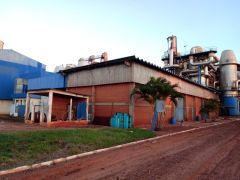 SUGAR AND ALCOHOL PLANTREFERENCE NUMBER: A-2511 SUGAR AND ALCOHOL PLANT CANE UNLOAD SECTOR THE CANE UNLOADING SECTOR IS EQUIPPED WITH THE EQUIPMENT LISTED BELOW IN THE CONDITION TO CARRY OUT A GRINDING OF 8400 TCD WHICH CORRESPONDS TO A HARVEST OF 1800000 TONNES OF CANE / YEAR • 01 HILO UNLOADER OF STORAGE • 01 HILO UNLOADER OF MILLING • 01 FEEDER SUGARCANE TABLE WITH INCLINATION OF 25 INCHES • 01 FEEDER SUGARCANE TABLE WITH INCLINATION OF 45 INCHES • 02 CRANES WITH CAPACITY OF 20 TONNES • 01 TRANSPORTER TYPE CUSCH - CUSH OF 40 INCHES • 02 MOTOR PUMP WITH CAPACITY OF 1000 M³/H TO 50 MCW FOR CANE WASHING • 01 CONTAMINATED FLUID TREATMENT SYSTEM • 01 METAL STRUCTURE BUILDING MEASURING 20000 X 100000 mm CANE PREPARATION SECTOR THE SUGARCANE PREPARATION SECTOR IS EQUIPPED WITH THE FOLLOWING AUTOMATED EQUIPMENT WITH THE CONTROL BY THE SUPERVISORY INSTALLED IN THE CONTROL ROOM AS SHOWN BELOW TO PERFORM A CRUSHING OF 7200 TCD WHICH CORRESPONDS TO A CROP OF 1600000 TONS OF SUGARCANE / YEAR • 01 METALLIC CONVEYOR OF 60 INCHES • 01 LEVELING OF CANE OF 60 INCHES • 01 CANE KNIVES SET TYPE COP-8 OF 60 INCHES • 01 CAN SHREDDER SET TYPE COP-5 OF 60 INCHES • 01 FEEDER ROLL 60 IINCHES • 01 RUBBER TRANSPORTER FOR CANE SHREDDED OF 60 INCHES • 01 TGM TURBINE FOR KNIVES SET • 01 TGM TURBINE FOR SHREDDER SET • 01 HIGH AND LOWER SPEED REDUCER OF KNIVES SET • 01 HIGH AND LOWER SPEED REDUCER OF SHREDDER SET • 01 REDUCER FOR METALLIC CONVEYOR • 01 REDUCER FOR FEEDER ROLL • 01 REDUCER OF SHREDDED CANE TRANSPORTER TYPE BELT MILLING CANE SECTOR THE CANE MILLING SECTOR OF THE PLANT IS EQUIPPED WITH THE FOLLOWING AUTOMATED EQUIPMENT WITH THE CONTROL BY THE SUPERVISORY INSTALLED IN THE CONTROL ROOM TO CARRY OUT A GRINDING OF 7200 TCD CORRESPONDING TO A 222 - DAY HARVEST TO GRIND 1600000 TONS. CANE / YEAR • 04 MILLS OF 32 X 60 INCHES • 03 INTERMIDIATE TRANSPORTER OF 60 INCHES • 01 ROTARY SIEVE FOR MILLING 300 TCD • 01 TGM TURBINE OF DRIVING THE 1º / 2º MILLS • 01 TGM TURBINE OF DRIVING OF 3º / 4º MILLS • 01 REDUCER OF HIGH AND LOW SPEED OF DRIVING THE 1º / 2º MILLS • 01 REDUCER OF HIGH AND LOW SPEED OF DRIVING THE 3º / 4º MILLS • 03 REDUCER INTERMEDIATE TRANSPORTER OF 60 INCHES • 02 PUMPS OF 1ST JUICE • 02 PUMPS OF JUICE IMBIBITION OF 3RD FOR 2ND MILL • 02 PUMPS OF JUICE IMBIBITION OF 4TH FOR 3RD MILLS • 02 PUMPS OF MIXED JUICE OF MILL FOR JUICE TREATMENT STEAM GENERATION SECTOR THE STEAM GENERATION SECTOR OF THE PLANT IS PREPARED TODAY TO PERFORM A 7200 TCD GRINDING CORRESPONDING TO A 220 - DAY HARVEST TO GRIND 1600000 TON. CANE / YEAR WITH THE FOLLOWING AUTOMATED EQUIPMENT WITH CONTROL BY THE SUPERVISORY INSTALLED IN THE CONTROL ROOM AS SHOWN BELOW • 01 BOILER N ° 01, MODEL: TS-3-150 MODIFIED FOR CBS-120-21 KG / CM² TODAY GENERATES AN AVERAGE OF 11000 KG / HR OF STEAM AT A PRESSURE OF 21 KG / CM² • 01 BOILER N ° 02, MODEL: TS-3-150-21 KG / CM² TODAY GENERATES AN AVERAGE OF 55000 KG / HR OF STEAM AT A PRESSURE OF 21 KG / CM² • 01 DEAERATOR WITH A CAPACITY OF 70 M³ • 01 78 INCHES BAGASSE METALLIC TRANSPORTER OF 32000 mm LENGTH • 01 48 INCHES BAGASSE TRANSPORTER FROM MILL TO BOILER • 01 48 INCHES BAGASSE RETURN TRANSPORTER FOR BOILER • 01 REDUCER OF BAGASSE TRANSPORTER FROM MILL TOBOILER • 01 REDUCER OF BAGASSE RETURN TRANSPORTER TOBOILER • 02 MOTO - PUMPS OF WATER FEEDING OF DEAERATOR • 02 MOTO - PUMPS OF WATER TREATMENT OF BOILER • 01 MOTO - PUMP WITH CAPACITY OF 300 M³/H TO 350 MCW FOR WATER FEEDING OF BOILER • 01 TURBO-PUMP WITH CAPACITY OF 300 M³/H TO 350 MCW FOR WATER FEEDING OF BOILER • 02 MOTO-PUMPS WITH CAPACITY OF 220 M³/H TO 50 MCW FOR WET SCRUBBER OF BOILER NO. 2 • 03 MOTO - PUMPS OF 40 M³/H TO 300 MCW • 01 METALLIC RESERVOIR WITH 200 M³ OF CONDENSED WATER CAPACITY POWER GENERATION SECTOR THE POWER GENERATION SECTOR IS EQUIPPED WITH THE FOLLOWING MODERN AND AUTOMATED EQUIPMENT LISTED BELOW TO MEET A GRINDING OF 8400 TCD • 01 THREE - PHASE GENERATOR OF 6250 KVA – 13800 VOLTS – 60Hz • 01 TGM STEAM TURBINE MODEL TM - 5000 • 01 REDUCER RENK - ZANINI WITH CAPACITY OF 5000 KW • SEVERAL ELECTRICALS PANELS OF THE GENERATOR • 01 TURBO GENERATOR HOUSE BUILDING • 02 WATER COOLING TOWERS FOR THE TURBO-GENERATOR • 02 MOTO - PUMPS OF 100 M³/H TO 30 MCW SUGAR FACTORY THE SUGAR FACTORY WAS SET UP BETWEEN 2007 / 2008 AND COMPLETELY AUTOMATED WITH THE CONTROL BY THE SUPERVISORY INSTALLED IN THE CONTROL ROOM, PRODUCING AN AVERAGE OF 500000 KG OF VHP SUGAR PER DAY, A VALUE CORRESPONDING TO A MILLING OF 5000 TCD. THE TRANSPORT OF THIS SUGAR MANUFACTURED AT THE DECASA PLANT IS BEING TRANSPORTED BY MEANS OF A BUCKET VEHICLE WITH A DESTINATION INFORMED BY THE CUSTOMER. FOR THIS PLANT TO PRODUCE CRYSTAL SUGAR IC - 150, WE WILL NEED TO ACQUIRE AND ASSEMBLE THE FOLLOWING EQUIPMENT • SULFITATION EQUIPAMENT • BAGGING EQUIPMENT OF 50 KG BAGS • BUILD OR RENT AN INFLATABLE WAREHOUSE TO STORE SUGAR WITH THE INSTALLATION OF THIS EQUIPMENT, THE SUGAR FACTORY IS PREPARED TO RECEIVE A MILLING OF 5000 TCD CORRESPONDING TO A DAILY PRODUCTION OF 500000 KG OF CRYSTAL SUGAR IC - 150 PER DAY ALCOHOL DISTILLERY THE DISTILLERY WAS INSTALLED IN 1982 WITH A CAPACITY OF 300000 LITERS OF HYDRATED ALCOHOL PER DAY. WHEN THE FORMER OWNER'S UNIT WAS SOLD TO THE OLIVAL TENÓRIO GROUP IN 2003, THE NEW ENTREPRENEUR INVESTED IN THE MANUFACTURE OF ALCOHOL IN 2006 BY INSTALLING ANOTHER COLUMN OF DISTILLATION WITH A CAPACITY OF 300,000 LITERS AND AUTOMATED 100% INCREASING ITS PRODUCTION CAPACITY TO 600,000 LITERS OF HYDRATED ALCOHOL PER DAY • 02 TYPE “A” DISTILLATION COLUMNS WITH CAPACITY TO PRODUCE 300 M³ OF ALCOHOL / DAY • 02 TYPE “B” RECTIFICATION COLUMNS WITH CAPACITY FOR PRODUCTION OF 300 M³ OF ALCOHOL / DAY • 01 TYPE “A” DISTILLATION COLUMN WITH CAPACITY FOR PRODUCTION OF 300 M³ OF ALCOHOL / DAY • 01 TYPE “B” RECTIFICATION COLUMN WITH CAPACITY FOR PRODUCTION OF 300 M³ OF ALCOHOL / DAY • 09 TUBULAR HEAT EXCHANGERS TYPE “K” • 02 TUBULAR HEAT EXCHANGERS TYPE “J” • 02 TUBULAR HEAT EXCHANGERS TYPE “E” • 02 TUBULAR HEAT EXCHANGERS TYPE “E1” • 02 TUBULAR HEAT EXCHANGERS TYPE “E2” • 02 TUBULAR HEAT EXCHANGERS TYPE “R” • 02 TUBULAR HEAT EXCHANGERS TYPE “R1” • 11 NEW FERMENTATION VATS WITH A CAPACITY OF 300 M³ • 03 PLATE HEAT EXCHANGERS FOR THE WORT • 05 PLATE TYPE HEAT EXCHANGERS FOR VATS • 01 VAT FOR WINE • 01 CO₂ RECOVERY COLUMN • 02 PUMPS WITH A CAPACITY OF 600 M³ / H - 50 MCA FOR THE COOLING SYSTEM OF THE PLATE HEAT EXCHANGERS • 01 PUMP WITH A CAPACITY OF 800 M³ / H FOR THE COOLING SYSTEM OF THE PLATE HEAT EXCHANGERS • 02 CENTRÍFUGES HAD - 90 • 04 CENTRÍFUGES HAD - 60 WITH THE INSTALLATION OF THIS EQUIPMENT, THE ALCOHOL DISTILLERY IS PREPARED TO PRODUCE 600000 LITERS OF ALCOHOL PER DAY, RECEIVING A MILLING OF 6500 TCD CORRESPONDING TO 2500000 TONS OF CANE / YEAR Learn More
SUGAR AND ALCOHOL PLANTREFERENCE NUMBER: A-2511 SUGAR AND ALCOHOL PLANT CANE UNLOAD SECTOR THE CANE UNLOADING SECTOR IS EQUIPPED WITH THE EQUIPMENT LISTED BELOW IN THE CONDITION TO CARRY OUT A GRINDING OF 8400 TCD WHICH CORRESPONDS TO A HARVEST OF 1800000 TONNES OF CANE / YEAR • 01 HILO UNLOADER OF STORAGE • 01 HILO UNLOADER OF MILLING • 01 FEEDER SUGARCANE TABLE WITH INCLINATION OF 25 INCHES • 01 FEEDER SUGARCANE TABLE WITH INCLINATION OF 45 INCHES • 02 CRANES WITH CAPACITY OF 20 TONNES • 01 TRANSPORTER TYPE CUSCH - CUSH OF 40 INCHES • 02 MOTOR PUMP WITH CAPACITY OF 1000 M³/H TO 50 MCW FOR CANE WASHING • 01 CONTAMINATED FLUID TREATMENT SYSTEM • 01 METAL STRUCTURE BUILDING MEASURING 20000 X 100000 mm CANE PREPARATION SECTOR THE SUGARCANE PREPARATION SECTOR IS EQUIPPED WITH THE FOLLOWING AUTOMATED EQUIPMENT WITH THE CONTROL BY THE SUPERVISORY INSTALLED IN THE CONTROL ROOM AS SHOWN BELOW TO PERFORM A CRUSHING OF 7200 TCD WHICH CORRESPONDS TO A CROP OF 1600000 TONS OF SUGARCANE / YEAR • 01 METALLIC CONVEYOR OF 60 INCHES • 01 LEVELING OF CANE OF 60 INCHES • 01 CANE KNIVES SET TYPE COP-8 OF 60 INCHES • 01 CAN SHREDDER SET TYPE COP-5 OF 60 INCHES • 01 FEEDER ROLL 60 IINCHES • 01 RUBBER TRANSPORTER FOR CANE SHREDDED OF 60 INCHES • 01 TGM TURBINE FOR KNIVES SET • 01 TGM TURBINE FOR SHREDDER SET • 01 HIGH AND LOWER SPEED REDUCER OF KNIVES SET • 01 HIGH AND LOWER SPEED REDUCER OF SHREDDER SET • 01 REDUCER FOR METALLIC CONVEYOR • 01 REDUCER FOR FEEDER ROLL • 01 REDUCER OF SHREDDED CANE TRANSPORTER TYPE BELT MILLING CANE SECTOR THE CANE MILLING SECTOR OF THE PLANT IS EQUIPPED WITH THE FOLLOWING AUTOMATED EQUIPMENT WITH THE CONTROL BY THE SUPERVISORY INSTALLED IN THE CONTROL ROOM TO CARRY OUT A GRINDING OF 7200 TCD CORRESPONDING TO A 222 - DAY HARVEST TO GRIND 1600000 TONS. CANE / YEAR • 04 MILLS OF 32 X 60 INCHES • 03 INTERMIDIATE TRANSPORTER OF 60 INCHES • 01 ROTARY SIEVE FOR MILLING 300 TCD • 01 TGM TURBINE OF DRIVING THE 1º / 2º MILLS • 01 TGM TURBINE OF DRIVING OF 3º / 4º MILLS • 01 REDUCER OF HIGH AND LOW SPEED OF DRIVING THE 1º / 2º MILLS • 01 REDUCER OF HIGH AND LOW SPEED OF DRIVING THE 3º / 4º MILLS • 03 REDUCER INTERMEDIATE TRANSPORTER OF 60 INCHES • 02 PUMPS OF 1ST JUICE • 02 PUMPS OF JUICE IMBIBITION OF 3RD FOR 2ND MILL • 02 PUMPS OF JUICE IMBIBITION OF 4TH FOR 3RD MILLS • 02 PUMPS OF MIXED JUICE OF MILL FOR JUICE TREATMENT STEAM GENERATION SECTOR THE STEAM GENERATION SECTOR OF THE PLANT IS PREPARED TODAY TO PERFORM A 7200 TCD GRINDING CORRESPONDING TO A 220 - DAY HARVEST TO GRIND 1600000 TON. CANE / YEAR WITH THE FOLLOWING AUTOMATED EQUIPMENT WITH CONTROL BY THE SUPERVISORY INSTALLED IN THE CONTROL ROOM AS SHOWN BELOW • 01 BOILER N ° 01, MODEL: TS-3-150 MODIFIED FOR CBS-120-21 KG / CM² TODAY GENERATES AN AVERAGE OF 11000 KG / HR OF STEAM AT A PRESSURE OF 21 KG / CM² • 01 BOILER N ° 02, MODEL: TS-3-150-21 KG / CM² TODAY GENERATES AN AVERAGE OF 55000 KG / HR OF STEAM AT A PRESSURE OF 21 KG / CM² • 01 DEAERATOR WITH A CAPACITY OF 70 M³ • 01 78 INCHES BAGASSE METALLIC TRANSPORTER OF 32000 mm LENGTH • 01 48 INCHES BAGASSE TRANSPORTER FROM MILL TO BOILER • 01 48 INCHES BAGASSE RETURN TRANSPORTER FOR BOILER • 01 REDUCER OF BAGASSE TRANSPORTER FROM MILL TOBOILER • 01 REDUCER OF BAGASSE RETURN TRANSPORTER TOBOILER • 02 MOTO - PUMPS OF WATER FEEDING OF DEAERATOR • 02 MOTO - PUMPS OF WATER TREATMENT OF BOILER • 01 MOTO - PUMP WITH CAPACITY OF 300 M³/H TO 350 MCW FOR WATER FEEDING OF BOILER • 01 TURBO-PUMP WITH CAPACITY OF 300 M³/H TO 350 MCW FOR WATER FEEDING OF BOILER • 02 MOTO-PUMPS WITH CAPACITY OF 220 M³/H TO 50 MCW FOR WET SCRUBBER OF BOILER NO. 2 • 03 MOTO - PUMPS OF 40 M³/H TO 300 MCW • 01 METALLIC RESERVOIR WITH 200 M³ OF CONDENSED WATER CAPACITY POWER GENERATION SECTOR THE POWER GENERATION SECTOR IS EQUIPPED WITH THE FOLLOWING MODERN AND AUTOMATED EQUIPMENT LISTED BELOW TO MEET A GRINDING OF 8400 TCD • 01 THREE - PHASE GENERATOR OF 6250 KVA – 13800 VOLTS – 60Hz • 01 TGM STEAM TURBINE MODEL TM - 5000 • 01 REDUCER RENK - ZANINI WITH CAPACITY OF 5000 KW • SEVERAL ELECTRICALS PANELS OF THE GENERATOR • 01 TURBO GENERATOR HOUSE BUILDING • 02 WATER COOLING TOWERS FOR THE TURBO-GENERATOR • 02 MOTO - PUMPS OF 100 M³/H TO 30 MCW SUGAR FACTORY THE SUGAR FACTORY WAS SET UP BETWEEN 2007 / 2008 AND COMPLETELY AUTOMATED WITH THE CONTROL BY THE SUPERVISORY INSTALLED IN THE CONTROL ROOM, PRODUCING AN AVERAGE OF 500000 KG OF VHP SUGAR PER DAY, A VALUE CORRESPONDING TO A MILLING OF 5000 TCD. THE TRANSPORT OF THIS SUGAR MANUFACTURED AT THE DECASA PLANT IS BEING TRANSPORTED BY MEANS OF A BUCKET VEHICLE WITH A DESTINATION INFORMED BY THE CUSTOMER. FOR THIS PLANT TO PRODUCE CRYSTAL SUGAR IC - 150, WE WILL NEED TO ACQUIRE AND ASSEMBLE THE FOLLOWING EQUIPMENT • SULFITATION EQUIPAMENT • BAGGING EQUIPMENT OF 50 KG BAGS • BUILD OR RENT AN INFLATABLE WAREHOUSE TO STORE SUGAR WITH THE INSTALLATION OF THIS EQUIPMENT, THE SUGAR FACTORY IS PREPARED TO RECEIVE A MILLING OF 5000 TCD CORRESPONDING TO A DAILY PRODUCTION OF 500000 KG OF CRYSTAL SUGAR IC - 150 PER DAY ALCOHOL DISTILLERY THE DISTILLERY WAS INSTALLED IN 1982 WITH A CAPACITY OF 300000 LITERS OF HYDRATED ALCOHOL PER DAY. WHEN THE FORMER OWNER'S UNIT WAS SOLD TO THE OLIVAL TENÓRIO GROUP IN 2003, THE NEW ENTREPRENEUR INVESTED IN THE MANUFACTURE OF ALCOHOL IN 2006 BY INSTALLING ANOTHER COLUMN OF DISTILLATION WITH A CAPACITY OF 300,000 LITERS AND AUTOMATED 100% INCREASING ITS PRODUCTION CAPACITY TO 600,000 LITERS OF HYDRATED ALCOHOL PER DAY • 02 TYPE “A” DISTILLATION COLUMNS WITH CAPACITY TO PRODUCE 300 M³ OF ALCOHOL / DAY • 02 TYPE “B” RECTIFICATION COLUMNS WITH CAPACITY FOR PRODUCTION OF 300 M³ OF ALCOHOL / DAY • 01 TYPE “A” DISTILLATION COLUMN WITH CAPACITY FOR PRODUCTION OF 300 M³ OF ALCOHOL / DAY • 01 TYPE “B” RECTIFICATION COLUMN WITH CAPACITY FOR PRODUCTION OF 300 M³ OF ALCOHOL / DAY • 09 TUBULAR HEAT EXCHANGERS TYPE “K” • 02 TUBULAR HEAT EXCHANGERS TYPE “J” • 02 TUBULAR HEAT EXCHANGERS TYPE “E” • 02 TUBULAR HEAT EXCHANGERS TYPE “E1” • 02 TUBULAR HEAT EXCHANGERS TYPE “E2” • 02 TUBULAR HEAT EXCHANGERS TYPE “R” • 02 TUBULAR HEAT EXCHANGERS TYPE “R1” • 11 NEW FERMENTATION VATS WITH A CAPACITY OF 300 M³ • 03 PLATE HEAT EXCHANGERS FOR THE WORT • 05 PLATE TYPE HEAT EXCHANGERS FOR VATS • 01 VAT FOR WINE • 01 CO₂ RECOVERY COLUMN • 02 PUMPS WITH A CAPACITY OF 600 M³ / H - 50 MCA FOR THE COOLING SYSTEM OF THE PLATE HEAT EXCHANGERS • 01 PUMP WITH A CAPACITY OF 800 M³ / H FOR THE COOLING SYSTEM OF THE PLATE HEAT EXCHANGERS • 02 CENTRÍFUGES HAD - 90 • 04 CENTRÍFUGES HAD - 60 WITH THE INSTALLATION OF THIS EQUIPMENT, THE ALCOHOL DISTILLERY IS PREPARED TO PRODUCE 600000 LITERS OF ALCOHOL PER DAY, RECEIVING A MILLING OF 6500 TCD CORRESPONDING TO 2500000 TONS OF CANE / YEAR Learn More -
 RAIN TEST CHAMBER WATER SPRAY SIMULATIONREFERENCE NUMBER: Y-2073 RAIN TEST CHAMBER WATER SPRAY SIMULATION THIS EQUIPMENT IS APPLICABLE TO THE TEST OF RAINPROOF DUST AND SAND SOAKED WATER OF VARIOUS AUTO PARTS, ELECTRONIC APPLIANCES, AND OTHER INDUSTRIAL ELECTRONIC PRODUCTS. AUTO PARTS INCLUDE THE TEST OF FULL SEALING STABILITY OF THE SYSTEM SUCH AS LAMPS, DOOR LOCKS, ELECTRICAL, INSTRUMENTS, DUST COVERS, ELECTRONIC HOUSEHOLD APPLIANCES, ETC. THE TESTED ITEMS ARE INSTALLED OR PLACE IN THE CENTER OF SEMICIRCLE BENDING TUBES AND BOTTOM AND SWING OF THE SPLASHED SAMPLES. THE AXIS IS IN A HORIZONTAL POSITION, AND THE SAMPLES ROTATES AROUND THE CENTERLINE DURING THE TEST. TECHNICAL PARAMETERS: CHAMBER SIZE: 600mm X 600mm X 600mm (WxDxH) DIAMETER OF SPRAY: ⊄0.4mm SPACING OF SPRAY HOLES: 50mm SPRAY PIPE DIAMETER: 16mm NOZZLE ANGLE ADJUSTABLE: 120 (IPX3) 180(IPX4) RADIUS OF SPRAY RING: R 375mm WATER PRESSURE: ADJUSTABLE WATER FLOW AS REQUIRED FLOW: 1 TO 7L PER MINUTE, FLOW SPEED ADJUSTABLE AIR VELOCITY: 10mm PER SECOND TEST TIME: 0 TO 999 MIN ADJUSTABLE SWING ANGLE AMPLITUDE OF SWING TUBE: ±45˙ ± 60˙ ±180˙ PENDULUM TUBE: IT IS DRIVEN BY SERVO MOTOR, WITH HIGH PRECISION AND ACCURATE TIME AND SWING WATER SUPPLY PIPELINE: PPR PIPE IS USED FOR EQUIPMENT WATER SUPPLY, WHICH IS ARRANGE ACCORDING TO BOX DISTRIBUTION AND CONTROLLED BY EQUIPMENT CONTROL SYSTEM CABINET. HEATING MODE: INCORPORATE STAINLESS STEEL HEATING PIPE, SHALLOW WATER PLATE SURFACE EVAPORATION. SPRAY CYCLE: THE SPRAY CYCLE IN THE BOX IS ADJUSTABLE, AND THE DOOR IS EQUIPPED WITH AN OBSERVATION WINDOW TO OBSERVE THE STATE OF THE SAMPLE IN THE BOX. WINDOW WIPED INSTALLED. QUANTITY: 1 Learn More
RAIN TEST CHAMBER WATER SPRAY SIMULATIONREFERENCE NUMBER: Y-2073 RAIN TEST CHAMBER WATER SPRAY SIMULATION THIS EQUIPMENT IS APPLICABLE TO THE TEST OF RAINPROOF DUST AND SAND SOAKED WATER OF VARIOUS AUTO PARTS, ELECTRONIC APPLIANCES, AND OTHER INDUSTRIAL ELECTRONIC PRODUCTS. AUTO PARTS INCLUDE THE TEST OF FULL SEALING STABILITY OF THE SYSTEM SUCH AS LAMPS, DOOR LOCKS, ELECTRICAL, INSTRUMENTS, DUST COVERS, ELECTRONIC HOUSEHOLD APPLIANCES, ETC. THE TESTED ITEMS ARE INSTALLED OR PLACE IN THE CENTER OF SEMICIRCLE BENDING TUBES AND BOTTOM AND SWING OF THE SPLASHED SAMPLES. THE AXIS IS IN A HORIZONTAL POSITION, AND THE SAMPLES ROTATES AROUND THE CENTERLINE DURING THE TEST. TECHNICAL PARAMETERS: CHAMBER SIZE: 600mm X 600mm X 600mm (WxDxH) DIAMETER OF SPRAY: ⊄0.4mm SPACING OF SPRAY HOLES: 50mm SPRAY PIPE DIAMETER: 16mm NOZZLE ANGLE ADJUSTABLE: 120 (IPX3) 180(IPX4) RADIUS OF SPRAY RING: R 375mm WATER PRESSURE: ADJUSTABLE WATER FLOW AS REQUIRED FLOW: 1 TO 7L PER MINUTE, FLOW SPEED ADJUSTABLE AIR VELOCITY: 10mm PER SECOND TEST TIME: 0 TO 999 MIN ADJUSTABLE SWING ANGLE AMPLITUDE OF SWING TUBE: ±45˙ ± 60˙ ±180˙ PENDULUM TUBE: IT IS DRIVEN BY SERVO MOTOR, WITH HIGH PRECISION AND ACCURATE TIME AND SWING WATER SUPPLY PIPELINE: PPR PIPE IS USED FOR EQUIPMENT WATER SUPPLY, WHICH IS ARRANGE ACCORDING TO BOX DISTRIBUTION AND CONTROLLED BY EQUIPMENT CONTROL SYSTEM CABINET. HEATING MODE: INCORPORATE STAINLESS STEEL HEATING PIPE, SHALLOW WATER PLATE SURFACE EVAPORATION. SPRAY CYCLE: THE SPRAY CYCLE IN THE BOX IS ADJUSTABLE, AND THE DOOR IS EQUIPPED WITH AN OBSERVATION WINDOW TO OBSERVE THE STATE OF THE SAMPLE IN THE BOX. WINDOW WIPED INSTALLED. QUANTITY: 1 Learn More -
 T-6546 PFE TESTER FOR PELLET FILTRATION EFFICIENCY OF SURGICAL MASKREFERENCE NUMBER: T-6546PFE TESTER FOR PELLET FILTRATION EFFICIENCY OF SURGICAL MASKINTRODUCTIONMEDICAL SURGICAL MASK PARTICLE FILTRATION EFFICIENCY PFE TESTER IS SUITABLE FOR MEDICAL INSTRUMENT INSPECTION CENTER, SAFETY PROTECTION INSPECTION CENTER, LABOR PROTECTION INSPECTION CENTER, DRUG INSPECTION CENTER, DISEASE PREVENTION AND CONTROL CENTER, TEXTILE INSPECTION CENTER, HOSPITAL, MASK AND RESPIRATOR MANUFACTURERS, ETC.FEATURESTHE PFE TESTER FOR PARTICLE FILTRATION EFFICIENCY OF SURGICAL MASKS IS EQUIPPED WITH A SPECIAL SALT AEROSOL GENERATOR, WHICH CAN PRODUCE AEROSOLS WITH SPECIFIC PARTICLE SIZE AND CONCENTRATION.EQUIPPED WITH A SERIES OF SPECIAL FIXTURE, SUITABLE FOR THE DETECTION OF ALL KINDS OF MASKS.BUILT-IN HIGH LIFE PHOTOMETER MODULE, SAMPLING TIME ACCUMULATION, PROMPT LIGHT CLEANING.AUTOMATIC CONTROL OF AEROSOL GENERATION, AUTOMATIC CALCULATION OF CAPTURE EFFICIENCY AND MASK AIRFLOW RESISTANCE, REDUCE HUMAN INTERVENTION.BUILT-IN HIGH PRECISION ELECTRONIC FLOWMETER AND HIGH PERFORMANCE SAMPLING PUMP TO ENSURE FLOW STABILITY.PARAMETERTEST FLOW: PARAMETER RANGE: (5 ~ 100) L/MIN; RESOLUTION: (5 ~ 100) L/MIN;MAXIMUM ALLOWABLE ERROR: ±1%PRESSURE DETECTION RANGE: PARAMETER RANGE: (0 ~ 2500) PA; RESOLUTION: 0.1PA; MAXIMUM ALLOWABLE ERROR: ±1%CONCENTRATION DETECTION RANGE: PARAMETER RANGE: (0.001 ~ 100) 0 G/L;DETECTION ACCURACY: 1% OF THE READ VALUE IN THE RANGE OF 0.01% TO 100%DETECTION REPEATABILITY: 5% OF THE READ VALUE IN THE RANGE OF 0.01% TO 100% MEDIAN DIAMETER OF SALT AEROSOL PARTICLES (CMD): (0.075±0.02)MMEDIAN AEROSOL PARTICLE NUMBER DIAMETER (CMD) (OPTIONAL): (0.185±0.02) MOPERATING TEMPERATURE: 20±5CLearn MoreINSTRUMENT NOISE: <60DB(A)POWER SUPPLY: AC220V±10%, 50HZMAIN MACHINE SIZE: (LENGTH 700 X WIDTH 720 X HEIGHT 1450) mmQUANTITY: 1
T-6546 PFE TESTER FOR PELLET FILTRATION EFFICIENCY OF SURGICAL MASKREFERENCE NUMBER: T-6546PFE TESTER FOR PELLET FILTRATION EFFICIENCY OF SURGICAL MASKINTRODUCTIONMEDICAL SURGICAL MASK PARTICLE FILTRATION EFFICIENCY PFE TESTER IS SUITABLE FOR MEDICAL INSTRUMENT INSPECTION CENTER, SAFETY PROTECTION INSPECTION CENTER, LABOR PROTECTION INSPECTION CENTER, DRUG INSPECTION CENTER, DISEASE PREVENTION AND CONTROL CENTER, TEXTILE INSPECTION CENTER, HOSPITAL, MASK AND RESPIRATOR MANUFACTURERS, ETC.FEATURESTHE PFE TESTER FOR PARTICLE FILTRATION EFFICIENCY OF SURGICAL MASKS IS EQUIPPED WITH A SPECIAL SALT AEROSOL GENERATOR, WHICH CAN PRODUCE AEROSOLS WITH SPECIFIC PARTICLE SIZE AND CONCENTRATION.EQUIPPED WITH A SERIES OF SPECIAL FIXTURE, SUITABLE FOR THE DETECTION OF ALL KINDS OF MASKS.BUILT-IN HIGH LIFE PHOTOMETER MODULE, SAMPLING TIME ACCUMULATION, PROMPT LIGHT CLEANING.AUTOMATIC CONTROL OF AEROSOL GENERATION, AUTOMATIC CALCULATION OF CAPTURE EFFICIENCY AND MASK AIRFLOW RESISTANCE, REDUCE HUMAN INTERVENTION.BUILT-IN HIGH PRECISION ELECTRONIC FLOWMETER AND HIGH PERFORMANCE SAMPLING PUMP TO ENSURE FLOW STABILITY.PARAMETERTEST FLOW: PARAMETER RANGE: (5 ~ 100) L/MIN; RESOLUTION: (5 ~ 100) L/MIN;MAXIMUM ALLOWABLE ERROR: ±1%PRESSURE DETECTION RANGE: PARAMETER RANGE: (0 ~ 2500) PA; RESOLUTION: 0.1PA; MAXIMUM ALLOWABLE ERROR: ±1%CONCENTRATION DETECTION RANGE: PARAMETER RANGE: (0.001 ~ 100) 0 G/L;DETECTION ACCURACY: 1% OF THE READ VALUE IN THE RANGE OF 0.01% TO 100%DETECTION REPEATABILITY: 5% OF THE READ VALUE IN THE RANGE OF 0.01% TO 100% MEDIAN DIAMETER OF SALT AEROSOL PARTICLES (CMD): (0.075±0.02)MMEDIAN AEROSOL PARTICLE NUMBER DIAMETER (CMD) (OPTIONAL): (0.185±0.02) MOPERATING TEMPERATURE: 20±5CLearn MoreINSTRUMENT NOISE: <60DB(A)POWER SUPPLY: AC220V±10%, 50HZMAIN MACHINE SIZE: (LENGTH 700 X WIDTH 720 X HEIGHT 1450) mmQUANTITY: 1 -
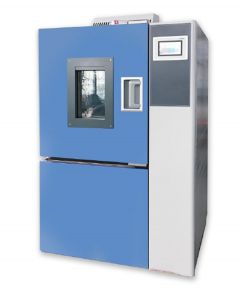 T-6549 CONSTANT TEMPERATURE AND HUMIDITY CHAMBER -FABRIC WATER VAPOR TRANSMISSION RATE
T-6549 CONSTANT TEMPERATURE AND HUMIDITY CHAMBER -FABRIC WATER VAPOR TRANSMISSION RATEREFERENCE NUMBER: T-6549
CONSTANT TEMPERATURE AND HUMIDITY CHAMBER -FABRIC WATER VAPOR TRANSMISSION RATE
TESTING METER (WITH MOISTURE PERMEABLE CUP)
TECHNICAL DESCRIPTION OF THE INSTRUMENT:
IT IS MAINLY USED TO MEASURE THE MOISTURE PERMEABILITY OF ALL KINDS OF FABRICS, INCLUDING PERMEABLE COATED FABRICS. STRUCTURE PRINCIPLE: ADOPT COMPUTER CONTROL, CREATING A CONSTANT TEMPERATURE, AND HUMIDITY TEST ENVIRONMENT, TEST ENVIRONMENT IN THE CONSTANT TEMPERATURE, AND HUMIDITY, MOISTURE VAPOR TRANSMISSION CUP, PLACED 6 SAMPLE INTO THE GLASS AND THE RUBBER GASKET SEAL, THE CONTAINING HYGROSCOPIC AGENT OR WATER SEAL IS SPECIFIED BY THE WET CUP PLACED IN THE FABRIC SAMPLE TEMPERATURE AND HUMIDITY OF THE ENVIRONMENT, THE SEAL MOISTURE VAPOR TRANSMISSION CUP ACCORDING TO A CERTAIN TIME (INCLUDING SAMPLE AND HYGROSCOPIC AGENT OR WATER) TO CALCULATE THE MOISTURE TRANSMISSION QUALITY CHANGE.
TESTING STANDARD:
GB19082-2009 MEDICAL PRIMARY PROTECTIVE CLOTHING
TECHNICAL REQUIREMENTS GUIDELINES FOR THE SELECTION OF YY-T1498-2016 MEDICAL PROTECTIVE CLOTHING
GB/T12704.1 DETERMINATION OF MOISTURE PERMEABILITY OF FABRICS --HYGROSCOPIC METHOD
DETAILED TECHNICAL SPECIFICATIONS AND CONFIGURATION:
TECHNICAL INDICATORS:
1. TEMPERATURE CONTROL RANGE: -40°C ~ 150°C;RESOLUTION; 0.1 °C
2. HUMIDITY CONTROL RANGE: 50%RH ~ 95% RH±5%
3. SPEED RANGE: 2mm ~ 60mm/MIN
4. CONTROL PRECISION: TEMPERATURE <0.1°C; HUMIDITY + / -1% RH OR LESS
5. CYCLIC WIND SPEED: 0.02 ~ 0.5M/S, 0.3 ~ 0.5M/S
6. TIME CONTROL: 1 ~ 9999H
7. MOISTURE PERMEABLE AREA: 2827 mm 2 (DIAMETER IS 60 mm --NATIONAL STANDARD)
8. QUANTITY OF PERMEABLE CUPS: 6 GB;
9. DRYING BOX CONTROL TEMPERATURE: ROOM TEMPERATURE ~ 199 °C
10. TEST TIME: 1 ~ 999H
11. DRYING BOX STUDIO SIZE: 490 X 400 X 215mm
INSTRUMENT CONFIGURATION:
1. ONE MAIN MACHINE
QUANTITY: 1
Learn More -
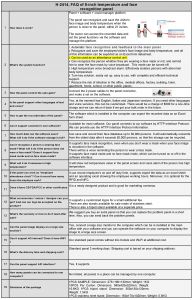 H-2414 FAQ for FACIAL RECOGNITION AND TEMPERATURE MEASURING SYSTEM, 8 inch panel
H-2414 FAQ for FACIAL RECOGNITION AND TEMPERATURE MEASURING SYSTEM, 8 inch panelHow does it work?
Learn More
What's the system function?
Can it be used as an attendance control unit? -
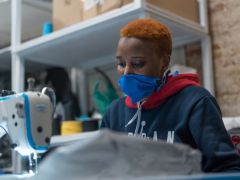 D-2388 What’s the Best Material for a Mask?
D-2388 What’s the Best Material for a Mask?Federal health officials have now recommended that we cover our faces with fabric during the coronavirus pandemic. But what material offers the most protection?
The Centers for Disease Control and Prevention has posted a no-sew mask pattern using a bandanna and a coffee filter as well as a video on making masks using rubber bands and folded fabrics found at home.
While a simple face covering can reduce the spread of coronavirus by blocking outgoing germs from coughs or sneezes of an infected person, experts say there is more variation in how much homemade masks might protect the wearer from incoming germs, depending on the fit and quality of the material used.
Scientists around the country have taken it upon themselves to identify everyday materials that do a better job of filtering microscopic particles. In recent tests, HEPA furnace filters scored well, as did vacuum cleaner bags, layers of 600-count pillowcases and fabric similar to flannel pajamas. Stacked coffee filters had medium scores. Scarves and bandanna material had the lowest scores, but still captured a small percentage of particles.
If you don’t have any of the materials that were tested, a simple light test can help you decide whether a fabric is a good candidate for a mask.
“Hold it up to a bright light,” said Dr. Scott Segal, chairman of anesthesiology at Wake Forest Baptist Health who recently studied homemade masks. “If light passes really easily through the fibers and you can almost see the fibers, it’s not a good fabric. If it’s a denser weave of thicker material and light doesn’t pass through it as much, that’s the material you want to use.”
Researchers say it’s important to remember that lab studies are conducted under perfect conditions with no leaks or gaps in the mask, but the test methods give us a way to compare materials. And while the degree of filtration for some homemade masks seems low, most of us — who are staying home and practicing social distancing in public — don’t need the high level of protection required for medical workers. More important, any face covering is better than none, especially if worn by a person who has the virus but doesn’t know it.
The biggest challenge of choosing a homemade mask material is to find a fabric that is dense enough to capture viral particles, but breathable enough that we can actually wear it. Some items being touted online promise high filtration scores, but the material would be unwearable.
Dressing Up for Work … at Home
Yang Wang, an assistant professor of environmental engineering at Missouri University of Science and Technology, worked with his graduate students to study various combinations of layered materials — including both air filters and fabric. “You need something that is efficient for removing particles, but you also need to breathe,” said Dr. Wang, who last fall won an international award for aerosol research.To test everyday materials, scientists are using methods similar to those used to test medical masks, which everybody agrees should be saved for medical workers who are exposed to high doses of virus from seeing infected patients. The best medical mask — called the N95 respirator — filters out at least 95 percent of particles as small as 0.3 microns. By comparison, a typical surgical mask — made using a rectangular piece of pleated fabric with elastic ear loops — has a filtration efficiency ranging from 60 to 80 percent.
Dr. Wang’s group tested two types of air filters. An allergy-reduction HVAC filter worked the best, capturing 89 percent of particles with one layer and 94 percent with two layers. A furnace filter captured 75 percent with two layers, but required six layers to achieve 95 percent. To find a filter similar to those tested, look for a minimum efficiency reporting value (MERV) rating of 12 or higher or a microparticle performance rating of 1900 or higher.
The problem with air filters is that they potentially could shed small fibers that would be risky to inhale. So if you want to use a filter, you need to sandwich the filter between two layers of cotton fabric. Dr. Wang said one of his grad students made his own mask by following the instructions in the C.D.C. video, but adding several layers of filter material inside a bandanna.
Dr. Wang’s group also found that when certain common fabrics were used, two layers offered far less protection than four layers. A 600 thread count pillow case captured just 22 percent of particles when doubled, but four layers captured nearly 60 percent. A thick woolen yarn scarf filtered 21 percent of particles in two layers, and 48.8 percent in four layers. A 100 percent cotton bandanna did the worst, capturing only 18.2 percent when doubled, and just 19.5 percent in four layers.
The group also tested Brew Rite and Natural Brew basket-style coffee filters, which, when stacked in three layers, showed 40 to 50 percent filtration efficiency — but they were less breathable than other options.
If you are lucky enough to know a quilter, ask them to make you a mask. Tests performed at the Wake Forest Institute for Regenerative Medicine in Winston-Salem, N.C., showed good results for homemade masks using quilting fabric. Dr. Segal, of Wake Forest Baptist Health, who led the study, noted that quilters tend to use high-quality, high-thread count cotton. The best homemade masks in his study were as good as surgical masks or slightly better, testing in the range of 70 to 79 percent filtration. Homemade masks that used flimsier fabric tested as low as 1 percent filtration, Dr. Segal said.
The best-performing designs were a mask constructed of two layers of high-quality, heavyweight “quilter’s cotton,” a two-layer mask made with thick batik fabric, and a double-layer mask with an inner layer of flannel and outer layer of cotton.
Bonnie Browning, executive show director for the American Quilter’s Society, said that quilters prefer tightly woven cottons and batik fabrics that stand up over time. Ms. Browning said most sewing machines can handle only two layers of fabric when making a pleated mask, but someone who wanted four layers of protection could wear two masks at a time.
Ms. Browning said she recently reached out to quilters on Facebook and heard from 71 people who have made a combined total of nearly 15,000 masks. “We quilters are very much in the thick of what’s going on with this,” said Ms. Browning, who lives in Paducah, Ky. “One thing most of us have is a stash of fabric.”
People who don’t sew could try a folded origami mask, created by Jiangmei Wu, assistant professor of interior design at Indiana University. Ms. Wu, who is known for her breathtaking folded artwork, said she began designing a folded mask out of a medical and building material called Tyvek, as well as vacuum bags, after her brother in Hong Kong, where mask wearing is common, suggested it. (DuPont, the maker of Tyvek, said in a statement that Tyvek is intended for medical apparel, not masks.) The folded mask pattern is free online, as is a video demonstrating the folding process. In tests at Missouri University and University of Virginia, scientists found that vacuum bags removed between 60 percent and 87 percent of particles. But some brands of vacuum bags may contain fiberglass or are harder to breathe through than other materials, and shouldn’t be used. Ms. Wu used a bag by EnviroCare Technologies, which has said it does not use fiberglass in its paper and synthetic cloth bags.
“I wanted to create an alternative for people who don’t sew,” said Ms. Wu, who said she is talking to various groups to find other materials that will be effective in a folded mask. “Given the shortage of all kinds of materials, even vacuum bags might run out.”
The scientists who conducted the tests used a standard of 0.3 microns because that is the measure used by the National Institute for Occupational Safety and Health for medical masks.
Linsey Marr, a Virginia Tech aerosol scientist and an expert in the transmission of viruses, said the certification method for respirators and HEPA filters focuses on 0.3 microns because particles around that size are the hardest to catch. While it seems counterintuitive, particles smaller than 0.1 microns are actually easier to catch because they have a lot of random motion that makes them bump into the filter fibers, she said.
“Even though coronavirus is around 0.1 microns, it floats around in a wide range of sizes, from around 0.2 to several hundred microns, because people shed the virus in respiratory fluid droplets that also contain lots of salts and proteins and other things,” said Dr. Marr. “Even if the water in the droplets fully evaporates, there’s still a lot of salt and proteins and other gunk that stays behind as solid or gel-like material. I think 0.3 microns is still useful for guidance because the minimum filtration efficiency will be somewhere around this size, and it’s what NIOSH uses.”
Learn More -
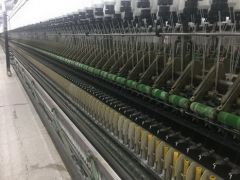 L-5506 ZINSER LINKED RING SPINNING MACHINES MODEL 320, YEAR 1989 TO 1990
L-5506 ZINSER LINKED RING SPINNING MACHINES MODEL 320, YEAR 1989 TO 1990REFERENCE NUMBER: L-5506
ZINSER LINKED RING SPINNING MACHINES MODEL 320, YEAR 1989 TO 1990
YEAR: 1989 TO 1990
MODEL: 320
1196 SPINDLES
RING DIAMETER: 42mm
FLANGE 1
GAUGE: 75mm
TUBE LENGTH: 220mm
QUANTITY: 18
Learn More -
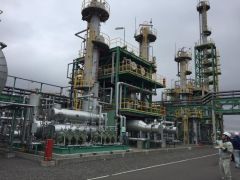 L-5744 LPG GAS MANUFACTURING PLANT, YEAR 2010 – PROPANE, ISO BUTANE, BUTANE, PENTANE
L-5744 LPG GAS MANUFACTURING PLANT, YEAR 2010 – PROPANE, ISO BUTANE, BUTANE, PENTANEREFERENCE NUMBER: L-5744
LPG GAS MANUFACTURING PLANT, YEAR 2010 – PROPANE, ISO BUTANE, BUTANE, PENTANE
MANUFACTURING YEAR: 2010
CAPACITIES:
LIQUEFACTION EQUIPMENT: 80,000 SM³/DAY
DISTILLATION EQUIPMENT: 65,000 SM³/DAY(120TON/DAY)
PRODUCT : PROPANE, ISO BUTANE, BUTANE, PENTANE
QUANTITY: 1
Learn More -
 L-4786 WAUKESHA VHP7044GSI GENERATORS, 1200 RPM, 50 & 60 Hz
L-4786 WAUKESHA VHP7044GSI GENERATORS, 1200 RPM, 50 & 60 HzL-4786 WAUKESHA VHP7044GSI GENERATORS, 1200 RPM, 50 & 60 Hz
CAN OPERATE AT 1150 KW, 1200 RPM, 60 Hz, 600/480 VAC
Learn More
OR
AT 1050 KW, 1000 RPM, 50 Hz, 400 VAC
WEATHER ENCLOSURE W/SKID
ENGINE DRIVEN RADIATOR ASSEMBLY
ENGINE CONTROLS & INTERFACE: WAUKESHA ENGINE ECU & AUXILIARY I/O BOX
KATO ALTERNATOR, 1200 KW / 1500 KVA, 6P6-3300, 6– POLES, 2 BEARING, 1200 RPM, 80 DEG C TEMP.
RISE (40 DEG. AMBIENT), IP-23 ENCLOSURE, PMG, CLASS 'H', 600/480 VOLT AC DUAL VOLTAGE, 3 PH,60HZ, 0.8 PF. FOUR (4) UNITS WITH
RENOLD COUPLING - 4 UNITS WITH MARATHON ALTERNATOR 480 VAC
ENGINE CONTROLS AND INTERFACE – ECU AND AUXILIARY I/O BOX
50 GALLON OIL MAKE-UP SYSTEM WITH LEVEL INDICATION
